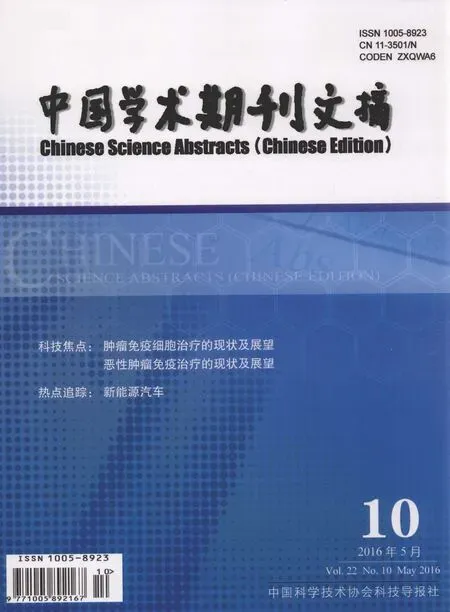新能源汽車
?
新能源汽車
·編者按·
2015年5月8日,國務院印發《中國制造2025》的通知,提到了“繼續支持電動汽車、燃料電池汽車發展,掌握汽車低碳化、信息化、智能化核心技術,提升動力電池、驅動電機、高效內燃機、先進變速器、輕量化材料、智能控制等核心技術的工程化和產業化能力,形成從關鍵零部件到整車的完整工業體系和創新體系,推動自主品牌節能與新能源汽車同國際先進水平接軌。”中國政府高度重視新能源汽車發展,將其確立為國家戰略。
新能源汽車是指采用非常規的車用燃料或動力轉換裝置作為動力來源,綜合車輛的動力控制和驅動方面的先進技術,形成的技術原理先進、具有新技術、新結構的汽車。包括純電動汽車、增程式電動汽車、燃料電池電動汽車、替代燃料汽車等。
隨著全球汽車保有量的不斷增加,一方面燃油大量消耗引起的能源危機變得日益嚴重,另一方面汽車尾氣排放引起環境污染的程度也越來越嚴重。而在能源緊缺、環境惡化的形勢下,加快發展節能環保的新能源汽車迫在眉睫。
隨著動力電氣化、材料輕量化、車輛智能化的新一代汽車技術大變革的深入,作為一個完全開放的市場,中國面臨的技術競爭壓力也越來越大。我們要盡最大努力抓住新能源、新材料、信息化科技帶來的新能源汽車新一輪技術變革機遇,實現新能源汽車動力系統全面升級,尤其是要加快實現動力電池革命性突破,以完善的科技體系支撐新能源汽車產業又好又快發展,最終實現中國汽車工業的技術強國夢。
本專題得到專家衣寶廉院士(中國科學院大連化學物理研究所)、黃學杰研究員(中國科學院物理研究所)、張劍波教授(清華大學汽車工程系)的大力支持。
·熱點數據排行·
截至2016年4月22日,中國知網(CNKI)和Web of Science(WOS)的數據報告顯示,以“新能源汽車(new energy vehicle)”“純電動汽車(electric vehicle)”“燃料電池電動汽車(fuel cell electric vehicle)”“氫燃料汽車(hydrogen fuel cell vehicle)”為詞條可以檢索到的期刊文獻分別為4292條與3989條,本專題將相關數據按照:研究機構發文數、作者發文數、期刊發文數、被引用頻次進行排行,結果如下。

研究機構發文數量排名(CNKI)

研究機構發文數量排名(WOS)

作者發文數量排名(CNKI)

作者發文數量排名(WOS)

期刊發文數量排名(CNKI)

期刊發文數量排名(WOS)
根據中國知網(CNKI)數據報告,以“新能源汽車(new energy vehicle)”“純電動汽車(electric vehicle)”“混合動力電動汽車(hybrid electric vehicle)”“燃料電池電動汽車(fuel cell vehicle)”“氫燃料汽車(hydrogen fuel cell vehicle)”為詞條可以檢索到的高被引論文排行結果如下。

國內數據庫高被引論文排行
根據Web of Science統計數據,以“新能源汽車(new energy vehicle)”“純電動汽車(electric vehicle)”“混合動力電動汽車(hybrid electric vehicle)”“燃料電池電動汽車(fuel cell vehicle)”“氫燃料汽車(hydrogen fuel cell vehicle)”為詞條可以檢索到的高被引論文排行結果如下。

國外數據庫高被引論文排行
·經典文獻推薦·
基于Web of Science檢索結果,利用Histcite軟件選取LCS(Local Citation Score,本地引用次數)TOP 50文獻作為節點進行分析,得到本領域推薦的經典文獻如下。
來源出版物:IEEE Transactions on Control Systems Technology, 2004, 12(3): 352-363
Electrical machines and drives for electric, hybrid, and fuel cell vehicles
Zhu, Z. Q; Howe, David
來源出版物:Proceedings of the IEEE, 2007, 95(4): 746-765
Fuel cell vehicles: Status 2007
Von Helmolt, Rittmar; Eberle, Ulrich
來源出版物:Journal of Power Sources, 2007, 165(2): 833-843
Electric, hybrid, and fuel-cell vehicles: Architectures and modeling
Chan, C. C; Bouscayrol, Alain; Chen, Keyu
來源出版物:IEEE Transactions on ehicular Technology, 2010, 59(2): 589-598
·推薦綜述·
來源出版物:Science, 2005, 308(5730): 1901-1905
Cleaning the air and improving health with hydrogen fuel-cell vehicles
Jacobson, MZ; Colella, WG; Golden, DM
Abstract:Converting all U.S. onroad vehicles to hydrogen fuel-cell vehicles (HFCVs) may improve air quality, health, and climate significantly, whether the hydrogen is produced by steam reforming of natural gas, wind electrolysis, or coal gasification. Most benefits would result from eliminating current vehicle exhaust. Wind and natural gas HFCVs offer the greatest potential health benefits and could save 3700 to 6400 U.S. lives annually. Wind HFCVs should benefit climate most. An all-HFCV fleet would hardly affect tropospheric water vapor concentrations. Conversion to coal HFCVs may improve health but would damage climate more than fossil/electric hybrids. The real cost of hydrogen from wind electrolysis may be below that of U.S. gasoline. In this paper, a model-based strategy for the real-time load control of parallel hybrid vehicles is presented. The aim is to develop a fuel-optimal control which is not relying on the a priori knowledge of the future driving conditions (global optimal control), but only upon the current system operation. The methodology developed is valid for those problem that are characterized by hard constraints on the state-battery state-of-charge (SOC) in this application-and by an arc cost-fuel consumption rate-which is not an explicit function of the state. A suboptimal control is found with a proper definition of a cost function to be minimized at each time instant. The “instantaneous” cost function includes the fuel energy and the electrical energy, the latter related to the state constraints. In order to weight the two forms of energy, a new definition of the equivalence factors has been derived. The strategy has been applied to the “Hyper” prototype of DaimlerChrysler, obtained from the hybridization of the Mercedes A-Class. Simulation results illustrate the potential of the proposed control in terms of fuel economy and in keeping the deviations of SOC at a low level. This paper reviews the relative merits of induction, switched reluctance, and permanent-magnet (PM) brushless machines and drives for application in electric, hybrid, and fuel cell vehicles, with particular emphasis on PM brushless machines. The basic operational characteristics and design requirements, viz. a high torque/power density, high efficiency over a wide operatingbook=13,ebook=17range, and a high maximum speed capability, as well as the latest developments, are described. Permanent-magnet brushless dc and ac machines and drives are compared in terms of their constant torque and constant power capabilities, and various PM machine topologies and their performance are reviewed. Finally, methods for enhancing the PM excitation torque and reluctance torque components and, thereby, improving the torque and power capability, are described. Within the framework of this paper, a short motivation for hydrogen as a fuel is provided and recent developments in the field of fuel cell vehicles are described. In particular, the propulsion system and its efficiency, as well as the integration of the hydrogen storage system are discussed. A fuel cell drivetrain poses certain requirements (concerning thermodynamic and engineering issues) on the operating conditions of the tank system. These limitations and their consequences are described. For this purpose, conventional and novel storage concepts will be shortly introduced and evaluated for their automotive viability and their potential impact. Eventually, GM’s third generation vehicles (i.a. the HydroGen3) are presented, as well as the recent 4th generation Chevrolet Equinox Fuel Cell SUV An outlook is given that addresses cost targets and infrastructure needs. With the advent of more stringent regulations related to emissions, fuel economy, and global warming, as well as energy resource constraints, electric, hybrid, and fuel-cell vehicles have attracted increasing attention from vehicle constructors, governments, and consumers. Research and development efforts have focused on developing advanced powertrains and efficient energy systems. This paper reviews the state of the art for electric, hybrid, and fuel-cell vehicles, with a focus on architectures and modeling for energy management. Although classic modeling approaches have often been used, new systemic approaches that allow better understanding of the interaction between the numerous subsystems have recently been introduced.
Optimal control of parallel hybrid electric vehicles
Sciarretta, A; Back, M; Guzzella, L
Keywords:road vehicle control; cost optimal control; fuel optimal control; suboptimal control; dynamic programming brushless drives; electric vehicles; electrical machines; hybrid vehicles; induction machines; permanent-magnet machines; switched reluctance machines hydrogen; automotive; fuel cell; hydrogen storage; LH2; CGH2 Electric vehicle (EV); fuel-cell vehicles (FCVs); hybrid electric vehicle (HEV); modeling; powertrains
文獻編號本領域經典文章題目第一作者來源出版物1 Cleaning the air and improving health with hydrogen fuel-cell vehicles Jacobson, MZ Science, 2005, 308(5730): 1901-1905 2 Optimal control of parallel hybrid electric vehicles 3 Electrical machines and drives for electric, hybrid, and fuel cell vehicles 4 Fuel cell vehicles: Status 2007 Sciarretta, A IEEE Transactions on Control Systems Technology, 2004, 12(3): 352-363 Zhu, Z Proceedings of the IEEE, 2007, 95(4): 746-765 Von Helmolt, 5 Electric, Hybrid, and Fuel-Cell Vehicles: Architectures and Modeling Rittmar Journal of Power Sources, 2007, 165(2): 833-843 Chan, C.C IEEE Transactions on ehicular Technology, 2010, 59(2): 589-598

